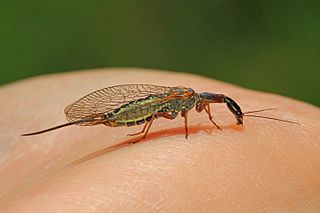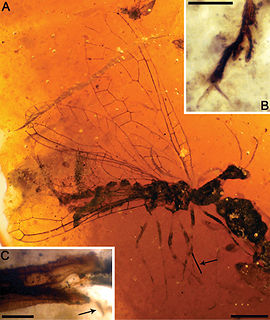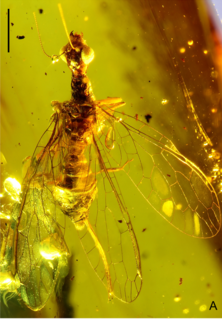 W
WSnakeflies are a group of predatory insects comprising the order Raphidioptera with two extant families: Raphidiidae and Inocelliidae, consisting of roughly 260 species. In the past, the group had a much wider distribution than it does now; snakeflies are found in temperate regions worldwide but are absent from the tropics and the southern hemisphere. They are a relict group and have been considered living fossils, as species from the early Jurassic period closely resemble modern-day species.
 W
WAgulla is a genus of modern snakeflies in the family Raphidiidae.
 W
WAlavaraphidia is an extinct genus of snakefly in the family Mesoraphidiidae. The genus is solely known from an Early Cretaceous, Albian age, fossil amber found in Spain. Currently, the genus comprises a single species, Alavaraphidia imperterrita.
 W
WAmarantoraphidia is an extinct genus of snakefly in the family Mesoraphidiidae. The genus is solely known from Early Cretaceous, Albian age, fossil amber found in Spain. Currently the genus comprises only a single species Amarantoraphidia ventolina.
 W
WArchiinocellia is an extinct genus of snakefly in the family Raphidiidae known from Eocene fossils found in western North America. The genus contains two species, the older Archiinocellia oligoneura and the younger Archiinocellia protomaculata. The type species is of Ypresian age and from the Horsefly Beds of British Columbia, while the younger species from the Lutetian Green River Formation in Colorado. Archiinocellia protomaculata was first described as Agulla protomaculata, and later moved to Archiinocellia.
 W
WCantabroraphidia is an extinct genus of snakefly in the family Mesoraphidiidae. The genus is solely known from fossil amber found in Cantabria, northern Spain, dating to the Albian age of the Early Cretaceous Period. Currently the genus comprises a single species Cantabroraphidia marcanoi.
 W
WDichrostigma is a genus of snakeflies in the family Raphidiidae. There are about five described species in the genus.
 W
WDichrostigma flavipes is a species of snakefly in the family Raphidiidae. It is found in Western Europe.
 W
WInocelliidae is a small family of snakeflies containing 8 genera of which one is known only from fossils. They are commonly known as inocelliid snakeflies. The largest known species is Fibla carpenteri known from fossils found in baltic amber.
 W
WMesoraphidiidae is an extinct family of snakeflies in the suborder Raphidiomorpha. The family lived from the Late Jurassic through the Late Cretaceous and is known from twenty-five genera. Mesoraphidiids have been found as both compression fossils and as inclusions in amber. The family was first proposed in 1925 by the Russian paleoentomologist Andrey Vasilyevich Martynov based on Upper Jurassic fossils recovered in Kazakhstan. The family was expanded in 2002 by the synonymizing of several other proposed snakefly families. The family was divided into three subfamilies and one tribe in a 2011 paper, further clarifying the relationships of the included genera.
 W
WNanoraphidia is an extinct genus of snakefly in the family Mesoraphidiidae containing the species Nanoraphidia electroburmica and Nanoraphidia lithographica.
 W
WNecroraphidia is an extinct genus of snakefly in the family Mesoraphidiidae. The genus is solely known from Early Cretaceous, Albian age, fossil amber found in Spain. Currently the genus comprises a single species, Necroraphidia arcuata.
 W
WPuncha ratzeburgi is a species of snakefly in the monotypic genus Puncha belonging to the family Raphidiidae.
 W
WPuncha ratzeburgi is a species of snakefly in the monotypic genus Puncha belonging to the family Raphidiidae.
 W
WRaphidia is a genus of snakefly, mainly found in Europe.
 W
WRaphidiidae is a family of snakeflies in the order Raphidioptera.
 W
WStyporaphidia is a genus of snakefly, belonging to the extinct family Mesoraphidiidae, containing up to two species, the type species Styporaphidia magia and tentatively Styporaphidia? hispanica. The genus was named from the Greek stypos meaning "stem" or "stump" and Raphidia, the type genus for, and most often used as, a stem for generic names in the order Raphidioptera. The species name of S. magia is from the Greek word mageia meaning "magic" while the species name for S.? hispanica is from the Latin Hispania meaning "Spain" in reference to the type locality of the species.